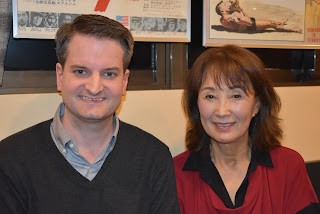In between actor Ichiro Ogura (left) and director Kazuki Omori.
Today, I attended a screening of director Kazuki Omori's first studio film, Orange Road Express (1978), produced by Shochiku. Going into the screening, I knew very little about the film, so I had no idea what to expect.
Kazuki Omori. Photo by Brett Homenick.
The film was quite amusing. It's a comedic (and highly stylized) road picture that centers on an elderly couple that steals cars from random people who try to be Good Samaritans. I didn't know until after the screening that Omori-san drew upon the social upheavals happening in Japan in the late 1960s and early '70s for this movie. Even though the content seems rather tame by contemporary standards, it seems that Orange Road Express was quite revolutionary in its day.
I also found out for the first time that Omori-san directed a commercial for the Lawson chain of convenience stores sometime in the 1990s. I wonder if the commercial dealt with time travel and/or bioengineering.
Ichiro Ogura. Photo by Brett Homenick.
Another guest at the event was actor Ichiro Ogura. Born on October 29, 1951, Ogura-san began his acting career in 1964 as a child actor. His film credits include: Nikkatsu's The Black Sheep (1967) as Takeshi Egawa, Ultraman Tiga: The Final Odyssey (2000) as Dr. Yao Naban, and Kamen Rider Hibiki & the Seven Senki (2005) as Suzu's father.
On the small screen, Ogura-san appears in episode 14 of Captain Ultra (1967) as Susumu, and episode 22 of Submersion of Japan (1974-75) as Junichi Ishiguro, among other tokusatsu credits.
It was great to meet Ogura-san for the first time, and I hope to have a chance to do so again in the future.


















































